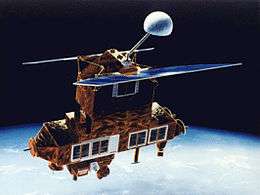Earth Radiation Budget Satellite
 The ERBS spacecraft | |
| Mission type | Earth observation |
|---|---|
| Operator | NASA |
| COSPAR ID | 1984-108B |
| SATCAT № | 15354 |
| Spacecraft properties | |
| Manufacturer | Ball Aerospace |
| Dry mass | 2,449 kilograms (5,399 lb) |
| Start of mission | |
| Launch date | 5 October 1984 |
| Rocket | Space Shuttle Challenger (STS-41-G) |
| Launch site | Kennedy LC-39A |
| End of mission | |
| Disposal | Decommissioned |
| Deactivated | 14 October 2005 |
| Orbital parameters | |
| Reference system | Geocentric |
| Regime | Low Earth |
| Semi-major axis | 68,844 kilometres (42,778 mi) |
| Perigee | 576 kilometers (358 mi) |
| Apogee | 589 kilometers (366 mi) |
| Inclination | 57 degrees |
| Period | 96.30 minutes |
| Epoch | 13 June 1988[1] |
The Earth Radiation Budget Satellite (ERBS) was a NASA scientific research satellite launched on October 5, 1984 to study the Earth's radiation budget and stratospheric aerosol and gases. It was carried into low earth orbit and deployed by the Space Shuttle Challenger, during the STS-41-G mission. The spacecraft was expected to have a two-year operation life, but ultimately, the mission provided scientific data about the Earth's ozone layer for more than two decades.
Data on the ozone layer provided by ERBS was key in the international community's decision-making process during the Montreal Protocol Agreement, which has resulted in a near elimination of CFCs in industrialized countries.

ERBS was one of three satellites in the Earth Radiation Budget Experiment and carried two instruments as part of that endeavor: the ERBE scanner (three detectors that study longwave radiation, shortwave radiation and total energy radiating from the Earth along a line of the satellite's path) and the ERBE non-scanner (five detectors measuring the total energy from the Sun, and the shortwave and total energy from the entire Earth disk and the area beneath the satellite). The second ERBE Instrument was aboard the NOAA-9 satellite when it was launched in January 1985, and the third was aboard the NOAA-10 satellite when it was launched in October 1986.
In addition, it carried the Stratospheric Aerosol Gas Experiment (SAGE II).
It was retired for budgetary reasons on October 14, 2005 as one of the longest-running spacecraft missions to date.
See also
External links
- ↑ McDowell, Jonathan. "Satellite Catalog". Jonathan's Space Page. Retrieved 10 July 2013.